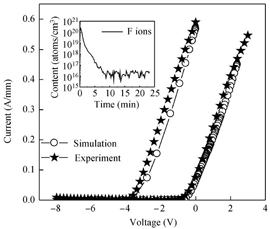
| Home | About Us | Contribute | Bookstore | Advertising | Subscribe for Free NOW! |
| News Archive | Features | Events | Recruitment | Directory |
News
18 August 2010
Fluoride push to nitride HEMT enhancement
Researchers at China’s National Key Laboratory of Application Specific Integrated Circuit and at the University of Electronic Science and Technology of China’s State Key Laboratory of Electronic Thin Films and Integrated Devices have used fluoride plasma treatment of nitride high-electron-mobility transistors (HEMTs) to create enhancement-mode (E-mode) devices with performance comparable to depletion-mode (D-mode) devices produced without treatment [Feng Zhihong et al, J. Semicond., vol31, p084001, 2010].
Presently, the best performing nitride HEMTs are D-mode (normally-on) devices. However, E-mode (normally-off) devices are desirable in terms of low energy consumption. Benefits would be seen in digital and radio-frequency design if high-performance E-mode nitride HEMTs could be developed.
E-mode devices have previously been developed using recessed gates or fluoride plasma treatments in the gate region. Fluoride treatments have been used to create E-mode HEMTs by groups based at Hong Kong University of Science and Technology (HKUST) and University of California Santa Barbara, for example.
The Chinese researchers grew their devices on n-type silicon carbide wafers using metal-organic chemical vapor deposition (MOCVD). The buffer layer consisted of 1.8μm of semi-insulating gallium nitride (GaN). A thin aluminum nitride (AlN) layer was deposited before applying a 20nm aluminum gallium nitride (AlGaN) barrier (21% Al). Finally, a 2nm GaN cap was added.
The device isolation was carried out using an inductively couple plasma reactive-ion etch. Electron-beam evaporation was used to deposit titanium-aluminum-nickel-gold source–drain contacts.
The 1μm non-recessed gates were formed in 1μm x 100μm windows by first treating the surface with carbon tetrafluoride (CF4) plasma in an RIE system and then applying nickel-gold for the electrode. Devices were also produced without the CF4 treatment.
A passitivation layer of silicon nitride was applied using plasma-enhanced chemical vapor deposition (PE-CVD). Finally, a rapid thermal anneal (RTA) lasting for 10 minutes was carried out at 400°C.
 Figure 1: (a) DC current–voltage characteristics of depletion-mode AlGaN/GaN HEMT. (b) DC and pulsed characteristics of an enhancement-mode AlGaN/GaN HEMT.
Figure 1: (a) DC current–voltage characteristics of depletion-mode AlGaN/GaN HEMT. (b) DC and pulsed characteristics of an enhancement-mode AlGaN/GaN HEMT.
The effect of the fluorine treatment is to push the devices from being D-mode to being E-mode (Figure 1), i.e. they block current when the gate is at zero potential (Vgs). The researchers report that their E-mode devices pass a similar current at 0V Vgs to that of the D-mode HEMT (i.e. without CF4 treatment) at –4V.
The threshold voltage of the E-mode device is estimated to be +0.35V, compared with –4V for the D-mode device. The transconductance of the E-mode device is 201mS/mm, representing “high performance”. The saturation current at Vgs = 4V is 667mA/mm. The current gain cutoff frequency (ft) and maximum oscillation frequency (fmax) are about 10.3GHz and 12.5GHz, respectively. The low performance of the maximum oscillation frequency is blamed on high parasitic capacitance deriving from the n-type SiC substrate.
The current collapse phenomenon, which can be a feature of the operation of nitride HEMTs at high bias, is described as being ‘low level’, with the researchers adding that this suggests there are no adverse effects associated with the fluoride-plasma-induced traps.
 Figure 2: Comparisons of simulation and experiment of AlGaN/GaN HEMTs performance before and after fluorine plasma treatment. Inset: secondary-ion mass spectrograph (SIMS) for sample treated by fluorine plasma.
Figure 2: Comparisons of simulation and experiment of AlGaN/GaN HEMTs performance before and after fluorine plasma treatment. Inset: secondary-ion mass spectrograph (SIMS) for sample treated by fluorine plasma.
The researchers carried out simulations (Figure 2) that suggest that the effect of the fluorine ions can be feasibly treated as acceptor traps at 1.8eV below the conduction-band energy.
![]() Search: Nitride HEMTs GaN AlN AlGaN Fluorine plasma
Search: Nitride HEMTs GaN AlN AlGaN Fluorine plasma
Visit: http://iopscience.iop.org/1674-4926/31/8/084001
Visit: www.uestc.edu.cn
The author Mike Cooke is a freelance technology journalist who has worked in the semiconductor and advanced technology sectors since 1997.